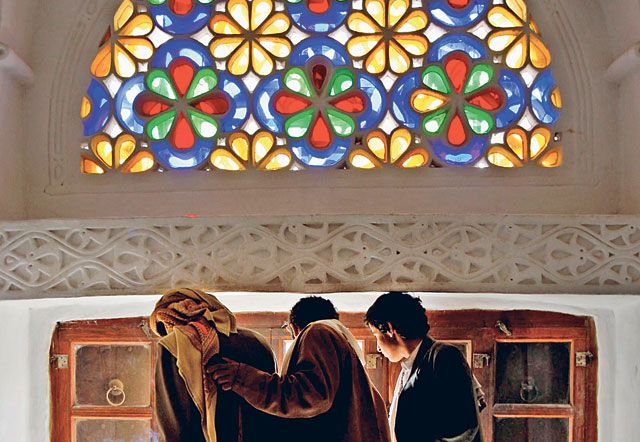Yemen, A treasure trove narrates the story of a country and its people as seen through the lenses of a group of photographers — two Yemenis among them. The pictures show various facets of the country, including poverty, isolation and ignorance.
One of the organisers, Melanie Radicke, said Yemen made her think she was in a place centuries behind. "The echoes of the call to prayer filling the air, sesame oil mills ‘powered' by lone camels walking endlessly around millstones and vendors selling little mountains of spices, frankincense, dates and colourful fabrics evoke a strong sense of being in a fairytale," she said. Radicke said she wanted to show the world images of Unesco World Heritage sites such as Sana'a and the walled city of Sheba.
Italian photographer Simone Santi was always interested in angles. "Lately I've been shooting images from [low angles], even from the pavement," he said. "Yemen is an architectural [haven] but my best memories [are associated with my] interaction with the locals. People are extremely friendly and welcoming despite living in a country isolated from the international community."
Manuel Salazar, in turn, is attracted to the possibility of finding artistic, social and visual expressions within aspects of the human experience. The Canadian photographer tries to capture pain in his images. "As an independent photographer who prefers to focus on people, I attempt to document what I see. I concentrate on hope and dignity [in] my subjects," he said.
Salazar is unimpressed by the talk of Yemen's heritage and culture. "The main point being missed is how these people are being [kept ignorant and poor through] cynical political manipulation. I think those are the real issues.
"To have the population of a country in a constant state of [lethargy as a result of] chewing qat is a great disfavour to the otherwise rich and once great Yemeni culture. ... Social instability and economic incoherence are steep prices to pay for a country that could develop a solid tourism infrastructure if the political will and sense of accountability were part of the local scene," he said.
Yemeni photographer Asiya Al Sharabi trains her lenses on the most "untouchable" issue in Yemen: women. "Yemen is a hard [place] for a woman to be successful in any career, especially photography. The issue extends beyond just that Yemeni women are culturally not allowed to be photographed. I [face] serious challenges in trying to turn the spotlight on women.
"I want to show them to the world [while hiding] their real identity because the society is governed by conservative rules. That is how viewers would see women represented in my photographs: No features are really shown, although you see her beauty and unique outfits. Women have worked really hard to overcome many challenges and I like to reflect that strength through my lens. I want to represent Yemeni women in their pain, in their hidden beauty. Through photography I will make sure that barriers of shyness between Yemeni women and the world are broken."
According to Al Sharabi, being a photographer in Yemen was very difficult. "Art is fast becoming a popular [avenue of] investment in the Middle East. [But] Yemen is absent from the international art scene because most art sold internationally is represented by galleries."
Al Sharabi looks forward to establishing her own gallery. "I want to work on a project that gives a voice to people who have been forgotten or misunderstood. Yemen is rich in subjects to photograph: people, costumes, daily life, traditions, places and architecture. The good thing about Yemen is that it is culturally diverse; each area has its own traditions, food, costumes, architectural styles and social life," Al Sharabi said.
For Lebanese photographer Souheil Semaan, Yemen was a fantastic country with beautiful scenery and friendly people. "I am more of a people person, and it is the people that attracted me most to this country. Yemen is not only a destination but also an experience. It is just a wonderful place that makes you feel you want to explore more."
Yemen, A treasure trove will be on at Total Arts Gallery from November 17 to December 7.
An open museum
"Yemen is an authentic piece of history. I felt I was entering an old era," said Gulf News photographer Ahmad Ramzan, who took part in ‘Yemen, A treasure trove'. "Yemen is a place of simplicity and originality, not to mention the generosity of the people. [They] receive guests with overwhelming hospitality and make you feel you are one among them."
However, Ramzan focused his lens on nature. "Yemen has authenticity in all aspects. Its nature, for instance, is such a great blessing that it must be framed and viewed by everyone. Yemen is an agriculturally rich land and that part should be documented. I feel there are many undiscovered zones of Yemen that I would love to renew my experience with."












